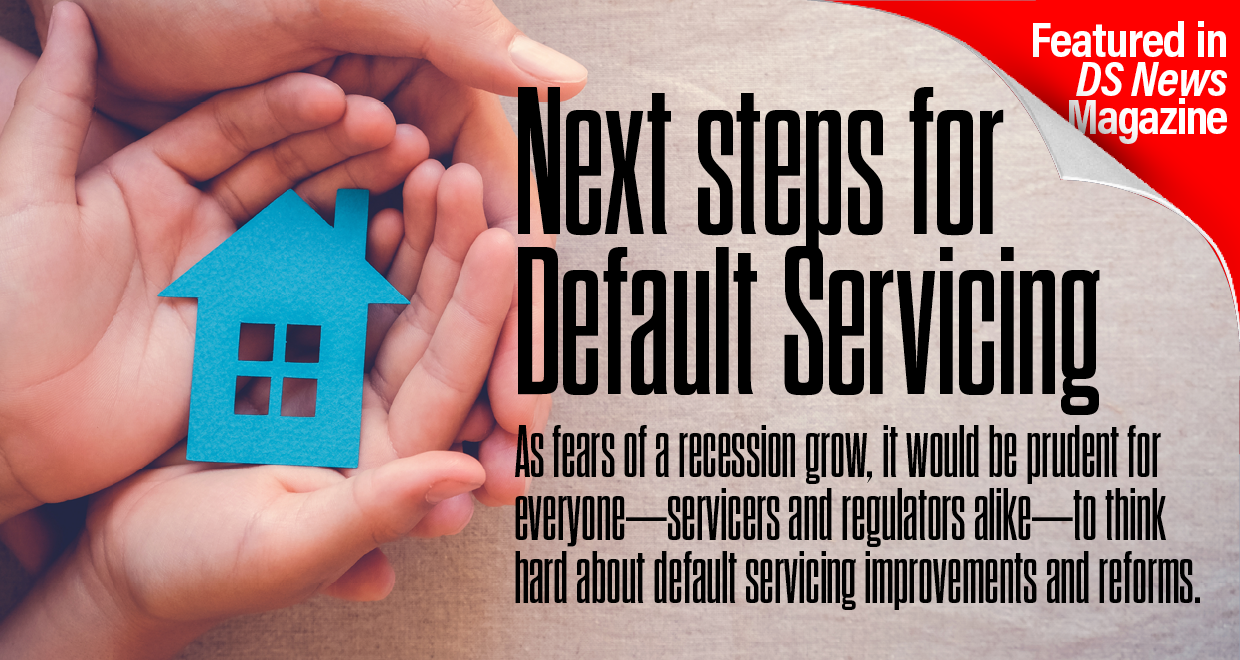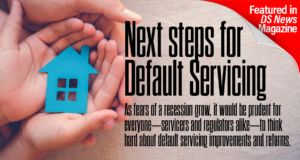
This piece originally appeared in the October 2022 edition of DS News magazine, online now [1].
More than two years after the COVID-19 pandemic took hold of the country, mortgage servicers may finally be in a position to come up for air and reflect on the whirlwind of the recent past. Among other things, the servicing industry has had to navigate the quick enactment of the CARES Act forbearance program, a constant barrage of agency and government-sponsored entity (GSE) guideline announcements and developments, a patchwork of state mandates, last-minute changes to the federal servicing rules in Regulation X, and intense public scrutiny from the Consumer Financial Protection Bureau (CFPB). To date, servicers have collectively provided assistance to many millions of mortgage loan borrowers who were impacted by the pandemic. While there is certainly still more work to be done, servicers’ willingness to help consumers and the overall effort put forth by the servicing industry at large has been admirable and commendable.
As the frequency and magnitude of COVID-19-related developments continues to slow down, now is a good time to reflect on the past couple of years and begin to plan for the future. What has worked well and could be incorporated into our standard servicing practices moving forward, and what lessons could be learned from mistakes that were made to improve the landscape for mortgage loan borrowers and their servicers in the future? Especially as fears of a recession grow, it would be prudent for everyone—servicers and regulators alike—to think hard about default servicing improvements and reforms.
Many industry groups and other interested parties have already been contemplating new forward-thinking policy ideas, such as putting more reliance on forbearance as a go-to option for consumers who are in the early stages of a financial hardship. However, there are also many legislative and regulatory reforms that should be considered as we move into a post-COVID-19 world. This article outlines a few such ideas.
Where We’ve Been
Coming out of the financial crisis of the late 2000s, the Dodd-Frank Wall Street Reform and Consumer Protection Act of 2010 created the CFPB and instructed the new agency to implement reforms in the mortgage servicing industry. In 2013, the CFPB released its final mortgage servicing rules, and they became effective in January 2014. The new rules covered three main areas related to default servicing: (1) early intervention, which established an early and ongoing communication framework for borrowers who become delinquent; (2) continuity of contact, which attempts to ensure that servicers have dedicated personnel that are knowledgeable and able to assist delinquent borrowers; and (3) loss mitigation, which establishes a procedural framework for working with borrowers to find alternatives to foreclosure, as well as dual-tracking restrictions to ensure foreclosure and loss mitigation are not moving forward simultaneously.
In 2016, the CFPB released a substantial set of amendments to the original servicing rules, and a fair number of the changes were in the loss mitigation area. Since that time, the only movement has related to COVID-19. In June of 2020, the CFPB recognized the need to relax the existing loss mitigation restrictions to facilitate servicers’ ability to quickly and efficiently offer a deferral option to COVID-19-impacted borrowers. Finally, in July 2021, the CFPB released a COVID-19 final rule that related exclusively to default servicing requirements in Regulation X. Among other things, the 2021 final rule imposed more prescriptive content requirements for many live contacts that are established with delinquent borrowers to ensure COVID-19 options are discussed, it further loosened the loss mitigation restrictions to allow servicers to offer some streamlined loan modification options to borrowers that may have been impacted by COVID-19, and it instituted a strict prohibition on the filing of new foreclosure actions for the last few months of 2021, with only very limited exceptions.
Where We’re Going
As we consider what the future of mortgage servicing should look like, we ought to acknowledge that, while there are many items that we might want to include on a theoretical wish list to improve servicers’ day-to-day lives, the practical reality is that any change in policy or in the regulatory environment must benefit consumers in a clearly articulable way. To have any meaningful chance of convincing the appropriate parties to make the recommended change, a proposal must not provide the industry with all the benefits, even if it is neutral for consumers; there must be some wins on the consumer side of the ledger.
With that in mind, one of the most obvious lessons that many learned from the pandemic was that streamlined loss mitigation options are a good thing and can be utilized to benefit servicers and borrowers alike. In early 2020, we saw that the CARES Act established a quick and efficient process for COVID-19- impacted borrowers to get immediate relief on their mortgage payments. The law created an extremely low bar for borrowers of federally backed mortgage loans to obtain up to 360 days of forbearance on their payments. Rather than having to submit mountains of documentation to demonstrate a possible hardship or evidence the borrower’s financial position, Congress mandated that servicers offer forbearance whenever it was requested provided that the borrower also attested to experiencing a COVID-19-related hardship. This could happen verbally, in writing, or even through a web portal or other online interface, making it extremely easy for borrowers to enter a forbearance program. Likewise, it also eliminated the need for servicers to expend the time and resources to work through a prolonged document chase process where they constantly try to obtain missing documentation that is needed to complete an application and for their review.
Shortly thereafter, the CFPB released its interim final rule to remove existing barriers in Regulation X that could have prevented servicers from quickly offering deferral options to COVID-19-impacted borrowers who were ready to resume making their regular monthly payment. A particular provision of Regulation X, which we commonly refer to as the “anti-evasion clause,” generally prohibits servicers from evaluating information received from a borrower and using it to offer loss mitigation options, unless and until the servicer collects a complete loss mitigation application from the borrower first. There are very limited exceptions to the anti-evasion clause including, for example, a carve-out for short-term forbearance plans, which allowed for the CARES Act framework to work seamlessly. Recognizing that its own rules were about to get in the way of helping millions of impacted mortgage loan borrowers, the CFPB issued an interim final rule to add COVID-19 deferral options to the limited list of anti-evasion clause exceptions. Once again, this immensely benefited both consumers and servicers.
Finally, along the same lines as the 2020 interim final rule, the CFPB’s 2021 COVID-19 final rule once again added a new exception to the anti-evasion clause in Regulation X, this time for certain streamlined modification options. At that time, the CFPB realized that the law accounted for, and allowed, forbearance and deferral options, but did not necessarily include a good way for servicers to quickly and efficiently evaluate borrowers who may need additional payment relief for a modification of the underlying loan. The result was another new exception to the anti-evasion clause, this time eliminating the barriers that otherwise would have stood in the way of quickly offering loan modification options to borrowers impacted by COVID-19, provided certain criteria are satisfied.
This recent history has clearly shown how streamlined loss mitigation options can simultaneously benefit consumers and the servicing industry. Unfortunately, though, there are currently only a limited number of exceptions to the anti-evasion clause, and many of them now relate to COVID-19 options. From both a policy and regulatory perspective, the CFPB ought to either discard of the anti-evasion clause altogether (and instead rely upon more permissive guardrails) or expand upon the enumerated exceptions. For example, in the context of a natural disaster, why shouldn’t a borrower be able to follow the same streamline path (forbearance followed by either a deferral or modification, or both) that a COVID-19-impacted borrower could take? Although the expansion should probably be broader than just for natural disaster scenarios, that minimum action should be a no-brainer.
Additionally, it is worth noting that, notwithstanding the CFPB’s existing regulatory restraints, both Fannie Mae and Freddie Mac currently instruct servicers to evaluate borrowers who have been impacted by natural disasters for their disaster payment deferral programs.
To make matters worse, they both require that servicers establish quality right party contact, evaluate certain information from the borrower, and then go so far as to say that servicers “must not require” borrowers to complete an application in order to be offered the deferral.
This creates obvious tension with the CFPB’s anti-evasion clause in Regulation X. Without an enumerated exception, can servicers legally offer those deferrals?
This highlights a final point worth mentioning briefly. Another thing that has become clear over the past couple of years is that consumers and mortgage servicers all benefit when there are clear rules of the road. Ambiguities, conflicts, and unresolved questions in new and existing laws or guidelines all create risks for servicers and inevitably will lead to variation amongst different entities.
Everyone wins when there are clear and consistent requirements. To that end, it would greatly benefit the industry and mortgage loan borrowers for the CFPB, government agencies, and the GSEs to come together and align their directives. Having inconsistencies and even misconceptions of what the law allows and what it does not—like the disaster deferral example—is unacceptable more than eight years after the framework became effective, and could easily be remedied. Particularly as the agencies and GSEs continue to add on to their already heavy-handed guides and requirements of servicers, full alignment is critical.
It is certainly easy to wonder whether there is even any appetite for making much needed reforms to improve the servicing landscape of the future and, admittedly, mortgage servicing does not have a place on the CFPB’s current rulemaking agenda. However, the history outlined above shows that the CFPB can and does make changes to the existing regulatory framework when there is good reason to do so.
In fact, that has happened multiple times just over the last handful of years. Therefore, there is reason to be optimistic that the CFPB will consider measured changes that benefit both consumers and the industry alike, hopefully sooner rather than later. Two items that should make all of our wish lists include (1) loosening the restrictions in Regulation X to allow for more streamlined options, and (2) harmonizing the various laws, guidelines, and directives to eliminate ambiguities, conflicts, and risks.
